By Frank Iannamico
Shortly after the semiautomatic SVT-40 Tokarev rifle entered Soviet service, work on a shortened carbine version commenced. Soviet designers Fedor Tokarev and Sergey Simonov submitted prototype carbines, but both were rejected after a poor performance during testing in 1940.
During 1941, Simonov submitted two more carbines designs, one of which passed initial testing and fifty more were ordered for field trials. However, on the 22nd of June, 1941, the Germans launched a massive invasion in an attempt to conquer the Soviet Union. As the Wehrmacht advanced, many factories had to be abandoned, delaying further progress on Simonov’s carbine until 1944. When work was finally resumed the carbine was re-chambered for the original mid-range 7.62x41mm cartridge (later changed to 7.62x39mm). The Simonov carbine was basically similar to his 1941 design, with only a few minor changes. The first Simonov carbines were shipped to Soviet troops on the Byelorussian front and to the Vistrel officer-training school. Initial reports stated that the carbine was easily reloaded, light and maneuverable, but there were also problems with sensitivity to dust, jams and failures to eject. Despite the problems, the trials commission recommended that Simonov continue to improve his carbine. During 1949 Simonov’s improved design was officially adopted as the 7.62 Simonov self-loading carbine, Model 1945 or SKS-45.

The SKS carbine or Samozariadnyia Karabina Simonova was the first Soviet series production weapon chambered for an intermediate-range cartridge. The SKS carbine was conceived during World War II to supplement the semiautomatic SVT 38 and SVT 40 (Samozaryadnaya Vintovka Tokareva) and 7.62x54mm bolt action Mosin Nagant battle rifles. The 7.62x39mm round would eventually replace the powerful long range 7.62x54R rifles and short range 7.62x25mm cartridge used in Soviet submachine guns.
The SKS is a gas operated, semiautomatic-only carbine that has a fixed 10-round magazine that is designed to be loaded through the top of the receiver using stripper clips. The Soviet SKS weighs approximately 8.8-pounds with an overall length of 40.16 inches, which is somewhat heavy and long for its midrange round. The rear sight is calibrated for a range of 100 to 1,000 meters, with a 300 meter battle sight position. The action’s locking mechanism is a tilting-bolt design.

Although well made and reliable, the SKS design was dated at the time of its post-war introduction, which was at the dawn of the select-fire, detachable magazine assault rifle. Work was already well underway on Kalashnikov’s AK-47 design around the same time period that the SKS was being placed in large scale production during 1949. Despite large numbers of SKS carbines being manufactured, its front line service in the Soviet Union was brief.
The SKS was distributed and manufactured in a number of Communist satellite nations, and was in front line service for a longer period of time in many of those countries. U.S. Forces encountered the SKS during the Vietnam War were it was fielded by Viet Cong guerilla fighters and the North Vietnamese Army.
In addition to the Soviet Union, the SKS was manufactured in Albania, China, East Germany, North Korea, Romania, Vietnam and Yugoslavia. Although the non-Soviet SKS carbines were the same basic design, there were small detail differences on the weapons manufactured in the aforementioned nations. Once shunned by collectors, many of the SKS variants that were once cheap and plentiful have become difficult to find and have gone up in value as interest in collecting them has increased.
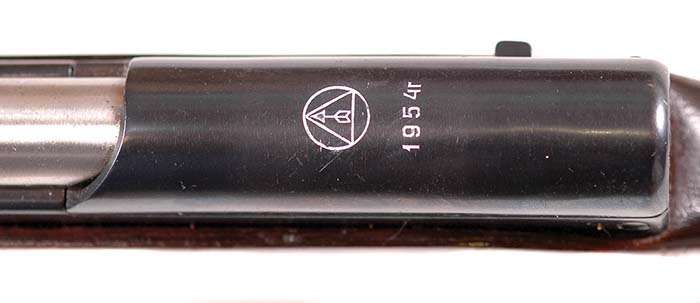
Soviet Production
The Soviet SKS carbines were manufactured at the Tula Arsenal from 1949 until 1956 and at the Izhevsk plant from 1953 to 1954. The Tula manufactured SKS carbines can be identified by an arrow inside of a star marking and date of manufacture on top of the receiver cover. The markings vary slightly in small details. Some of the early 1949 Tula markings were rather crudely done. The Tula markings were changed during 1955-1956 to a small star on the left side of the receiver. The Izhevsk plant’s SKS two year production run was short compared to the Tula Arsenal, making the Izhevsk carbines less common. The Izhevsk SKS carbines are identified by an arrow in a triangle inside of a circle symbol along with a date of manufacture, which like the Tula markings, can vary slightly in small details. Most original stocks were made of birch, except for very late Tula production which were laminated.
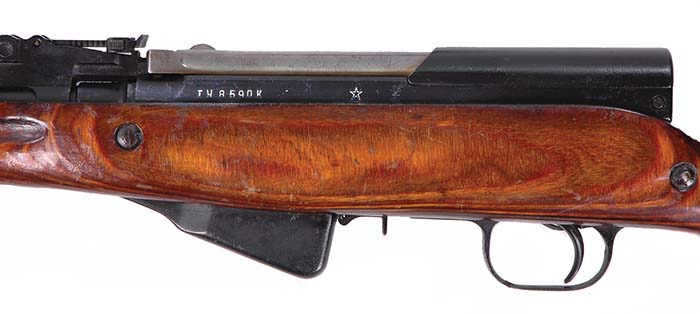
When first imported to the U.S. during the 1990s, the Soviet SKS carbines sold for as little as $99. Most had undergone an arsenal rebuild and appeared in like-new condition. A few features that may appear on refurbished rifles are Soviet rebuild markings that include a box symbol with a line inside or a diamond icon on the top cover or buttstock, blued bayonet and bolt, black painted parts, XXXed out or mismatched serial numbers, or a laminated replacement stock. There were a few Soviet SKS carbines imported that had not undergone the rebuild process; these rifles are highly desired by collectors. Some Soviet SKS carbines have additional “new” receiver serial numbers that were added by the importer. This came about as a result of an ATF directive claiming that original serial numbers having Cyrillic or non-Roman characters were not being properly recorded by FFL dealers transferring the carbines making them difficult to trace by the ATF.

Albanian Production
During the Cold War period the Soviets began to supply military aid to Albania. The Soviet military supply line ended when Albania cut its ties with Russia in 1961 and in 1968 Albania withdrew from the Warsaw Pact. Communist China also assisted Albania with military hardware, which included Chinese Type 56 SKS rifles, and Type 56 milled receiver AK rifles. After Albania broke ties with the Soviet Union, and left the Warsaw Pact, the country continued its relationship with China.
China provided technical assistance and parts to Albania in order to help them establish their own weapons production, which began with the SKS rifle, at the Uzina e Municioneve Gramsh state-owned factory in central Albania. Series production of the Albanian SKS known as the Pushkë Gjysmë Automatiku Shqiptar tipi 56 (Albanian Semi-Automatic Rifle, Model/Type 56) began in 1962, with the Type 56 designation originating with the original Chinese SKS. Also in 1962, the manufacture of M43, 7.62x39mm ammunition was established at the state owned M Poliçan factory.
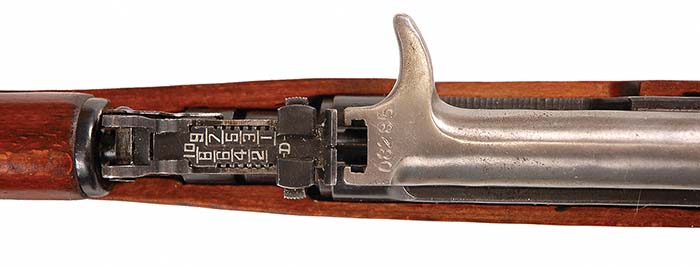
The Albanian SKS differs slightly from its Soviet made counterpart by having a long three vent handguard that extends out to the gas block. The buttstock has two separate compartments for maintenance items and a sling swivel on the left side. The 10 round magazine has a slightly different shape than other SKS carbines. The underfolding bayonet is a spike style and black in color. The most obvious difference from other SKS carbines is its hook-type cocking handle. Albanian serial numbers are located on the left side of the receiver and on most major components. The serial numbers generally have three to six numbers followed by a dash and a two digit year of manufacture. The 300 meter battle sight position is marked with a letter D. Large numbers of the Albanian SKS carbines and stores of 7.62x39mm ammunition were destroyed by the United Nations disarming initiative after the Balkan wars. Several NATO countries, including the United States and Great Britain, supplied funding for the destruction project. Only a limited number of Albanian SKS rifles were imported during 2002, the average price was $229.
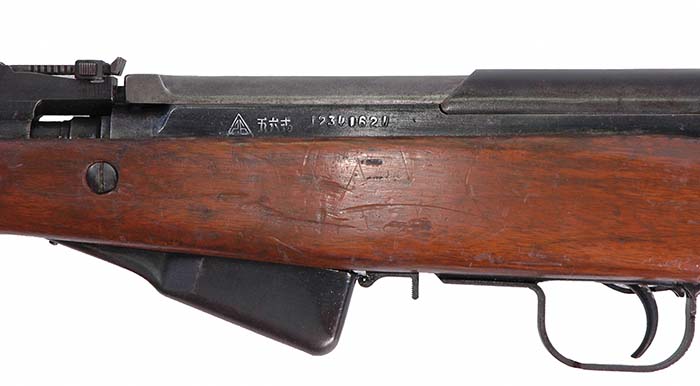
Chinese Production The Type 56
Chinese production of the Type 56 (SKS) carbine was undertaken during 1956 by a large number of arsenals, and remained in production longer than any other country. In addition to military carbines, China made a large number of their commercial Type 56 carbines for export, primarily for the U.S. civilian market. Chinese SKS carbines were first imported during the 1980s.
Military production of Type 56 carbines can be identified by an arsenal symbol on the left side of the receiver. One of the most common is a number 26 inside of a triangle, the logo of the Jianshe Arsenal. There were a number of different factory codes used by China. The Chinese characters located near the factory code represents “56 Type.” Most Type 56 carbine serial numbers are numeric except for very early production that was assisted by Soviet technicians; these serial numbers were preceded by a letter. Rear sight battle sight positions markings vary from a Cyrillic letter P (P) used on early manufacture, a letter D, Roman numeral III or a number 3.
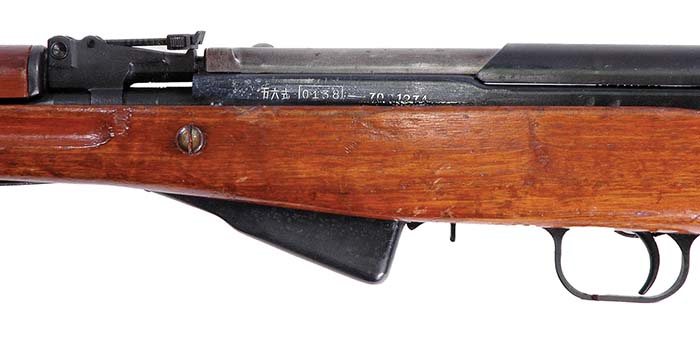
Due to the large number of factories involved in production there are many small detail differences in Chinese production of their SKS carbines. During early manufacture at the arsenals many milled parts were used, as production continued into the mid 1960s, stamped parts began to replace labor intensive machined ones. One of the first components to be fabricated from sheet metal was the trigger group; eventually some receivers were made of sheet metal. Another cost saving initiative was to pin the barrels to the receivers instead of having to thread the barrel and receiver. Milled lightening cuts in the bolt carriers and other parts were eliminated to save machining. Two types of folding bayonets were used during production in China; the spike style and a blade type.
The Chinese Type 56 SKS carbines are the most common of the genre in the U.S. Some are surplus Chinese military, but most are commercial variants made for the U.S. market. At one time the Chinese SKS carbines were very inexpensive, advertised as low as $79.

East Germany Karabiner-S
The East German version of the SKS is the Karabiner-S. Some of the unique features include a slot in the buttstock for attaching a sling, lack of a trap door in the buttstock for a cleaning kit and there is no cleaning rod, which is normally stored under the barrel on other SKS carbines. The factory markings are located on the left side of the receiver, the first two numbers preceding the serial numbers indicate the year of manufacture. Rear sights are marked with the letters SV. Stocks were made of laminated wood. There are also East German issued Soviet manufactured SKS carbines; these can be identified by a triangle with a number 1 inside it, marked on the receiver near the serial number. East German SKS carbines are somewhat rare. There may be other variants and features, but because of the rarity of the weapons very few are available for study. Many of the East German SKS carbines were destroyed after the reunification of Germany. Most of the East German SKS carbines in the U.S. were war trophies brought back from Vietnam.
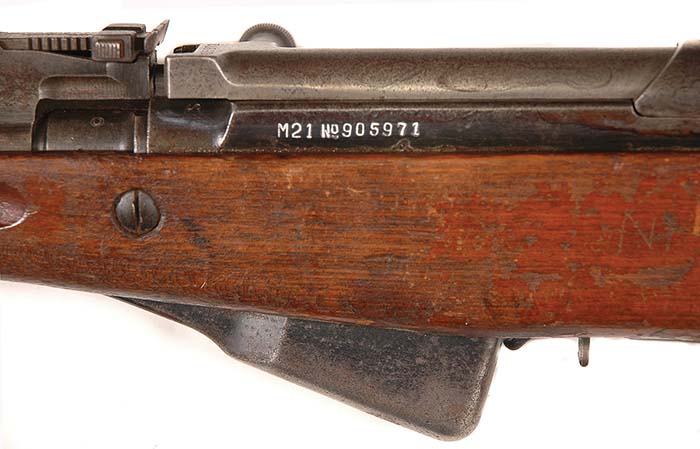
North Korea Type 63
The North Korean SKS, designated as the Type 63, is similar to the Soviet configuration. The North Korean star in a circle logo and 63 and a Hangul character representing “Type” are stamped on the receiver’s top cover. The battle sight position on the rear sight leaf is a Hangul character that translates to “height.” Stocks are made of laminated birch with two small reinforcing pins in the wrist area and two pins in the foregrip area. The underfolding bayonet is a blade type. The North Koreans fielded a grenade launching model with a launching sight attached to the left side of the receiver, a gas cut-off valve on the gas block and a detachable clamp-on launching tube. The grenade launcher appears to be a compilation of the U.S. designed M8 and M1 launchers. There may be other variants and features, but because of the rarity of the Type 63 carbines very few have been available for an in-depth study. North Korean carbines were never imported to the U.S. Those that are in the U.S. are most likely Vietnam War trophies.
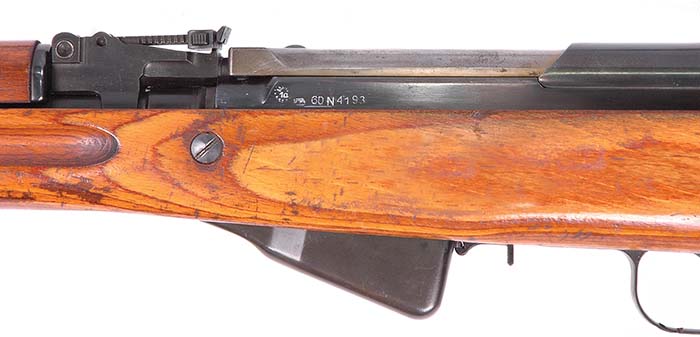
Romania M56
The Romanian SKS designated as the Model 56 was manufactured in Romania from 1956 to 1962. The serial numbers begin with two letters followed by sequence numbers, followed by the year of manufacture. The M56 carbines were produced in the Uzina Mecanica Cugir plant in Transylvania. The Cugir factory’s arsenal mark is similar to the Izhevsk Arsenal of Russia, a triangle with a vertical pointing arrow inside but without fletching. The 300-meter battle sight position on Romanian SKS rifles is marked with a letter I. The bayonet is the blade type with dull chrome plating. The major parts are marked with the full serial number but the bolt, bolt carrier, receiver and barrel are marked with a similar one to three digit number. The stock is beech wood with a sling swivel located on the bottom. A number of M56 carbines have been imported into the U.S. In 2002, Romanian SKS carbines were offered for $150.

North Vietnam
The Vietnam SKS carbines are marked with a small star with a 1 inside of it, located on the left side of the receiver. The battle position on the rear sight leaf is marked with a Cyrillic letter P. Documented serial numbers are all in the 620,000 to 650,000 range. One of the rarest SKS variants, those in the U.S. are trophies that were brought back from the Vietnam War as none were ever imported.

Yugoslavia M59, M59/66
The Yugoslavian SKS is the Model 59. First manufactured in 1959, the M59 has a few minor differences from the Russian SKS. One is the radius on the front of the gas tube and the stock is made of beech wood. There are matching serial numbers on most of the parts. The battle sight position on the rear sight leaf is marked with a letter I.
The M59 was modified in 1966 to the Model 59/66 that has a permanently attached NATO spec 22mm diameter grenade launcher, gas cut off valve and flip up grenade sight. The attachment of the launcher tube to the barrel added 3.74 inches (95mm) to the weapon’s overall length. There are several variations of the grenade launcher tube configuration. Later tritium and/or phosphorus night sights were added and this variation is often referred to as the 59/66A1. The Yugoslavian SKS variants do not have chrome-lined barrels and chambers because the technology to apply it wasn’t available in that country during production. Manufacture of the 59/66 started in 1966 and lasted until 1970. A large number of the Yugo 59/66 rifles have been imported, many in new or like new condition. During 2003 the Yugo SKS carbines were advertised for as low as $89.
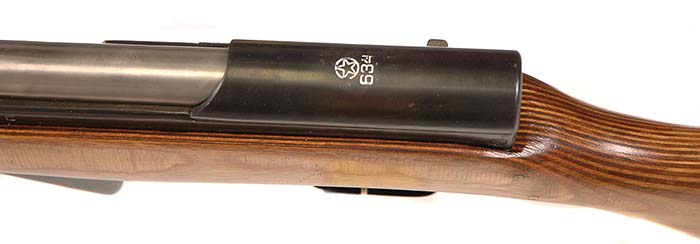
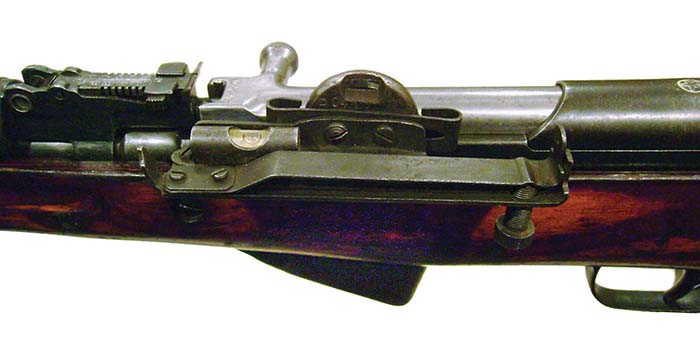
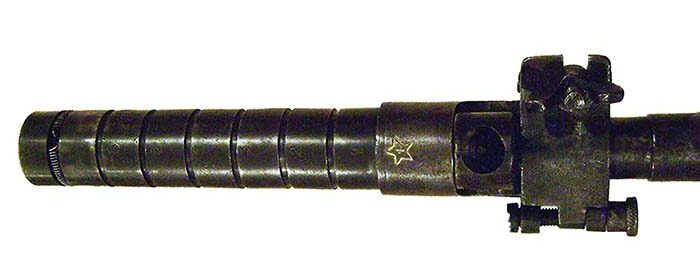


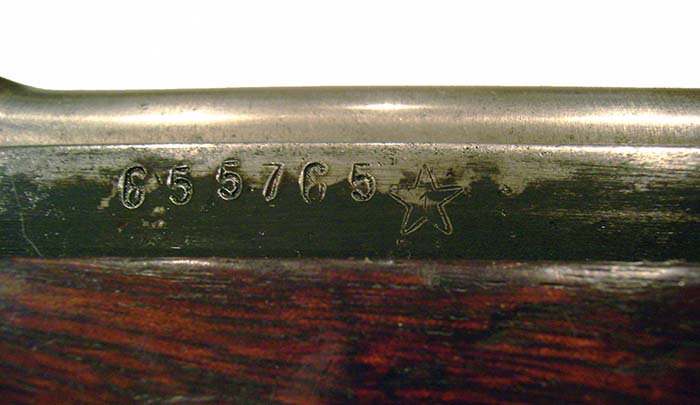
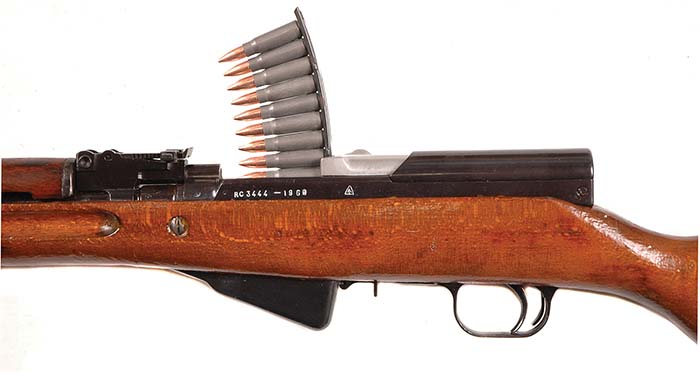


| This article first appeared in Small Arms Review V17N4 (December 2013) |










